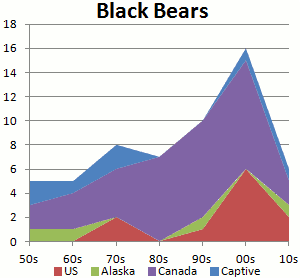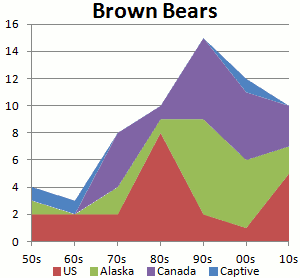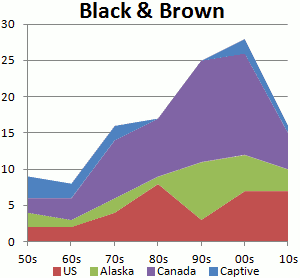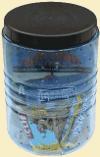
Hiking in Bear Country
 Bears are reclusive and would just as soon not meet you or any other humans. You just have to let them know you're in the neighborhood and behave like a well-mannered guest using a bit of common sense. There are very few bear attacks and those occur only in territory inhabited by bears, so bear danger for hikers is very low.
Bears are reclusive and would just as soon not meet you or any other humans. You just have to let them know you're in the neighborhood and behave like a well-mannered guest using a bit of common sense. There are very few bear attacks and those occur only in territory inhabited by bears, so bear danger for hikers is very low.
Bear Aware
 Since you are a visitor, you should be aware of how to behave in bear country. Bears are always looking for food and instinctively try to get the most food for the least amount of work. Some common steps to take in bear country:
Since you are a visitor, you should be aware of how to behave in bear country. Bears are always looking for food and instinctively try to get the most food for the least amount of work. Some common steps to take in bear country:
- Educate everyone in your party about the procedures to follow when a bear is seen. Make sure they understand that this is serious business so they don't do stupid things at the wrong time.
- Keep your eyes open for signs of bears. Footprints, droppings, trampled vegetation, clawed up tree trunks, overturned rocks, ripped up rotting logs.
- Invest in some bear spray before entering bear country. Know how and when to use it.
- Hike in groups. This gives you people to talk to, making noise is important to warn bears of your approach.
- Feel the wind. If you are hiking into the wind, your scent will not reach bears ahead of you and the chances of encounter are higher. Be aware and consider making more warning noise.
- Feel the land. Hiking across open meadows, ridges, or hillsides provides the opportunity for spotting bears at a distance. Hiking in gullies, thick forests, or along streams masks noise and scent and increases possibility of encounters.
- Dispose of garbage in bear-proof containers, if they are available.
- Hang all food, garbage, and smellable items in secure bear bags. Locate two trees about 200 feet from your campsite and at least 20 feet apart. Hang your smellables between them at least 12 feet up.
- Never eat or even bring smellables into your tent. This includes toothpaste, perfume, snacks, gum, ... anything with an odor. This also includes the clothes you cooked in - put on different clothes for sleeping.
- Cook at least 200 feet downwind from your tent. Even better, stop and cook your meal a mile before stopping to camp. Don't even open your food or garbage bag in camp.
- Clean all dishes immediately. Do your washing 200 feet from camp.
- Make sure you leave a spotless campsite. Remove all reason for a bear to visit this location looking for food.
When You See a Bear
 If you notice a bear at a distance, stay calm and assess your situation. Give the bear a wide privacy space - make a very wide 300 foot detour or go back the way you came and take a different route.
If you notice a bear at a distance, stay calm and assess your situation. Give the bear a wide privacy space - make a very wide 300 foot detour or go back the way you came and take a different route.
If the bear is close when you first notice it, the situation requires more immediate evaluation and action:
- Gather your group close together and make sure everyone understands there is a bear present.
- Get your bear spray out if you have it. Otherwise, be ready with hiking sticks for protection.
- Talk in a calm voice so the bear hears you and your group hears you.
- Have your group slowly back away, the same direction from which you came if possible. But, don't run away.
- Be ready for a 'bluff' charge where the bear lunges but then stops. The bear is trying to scare you off. Continue to back away calmly without losing your cool and turning to run.
If the bear continues to follow you, at some point you will come to the conclusion that the bear is considering you as prey. You need to convince the bear that you are not easy prey and will be a tough fight.
- Stop and stand your ground with whatever weapon you have available - hiking stick, branch, or rocks.
- Face the bear and look directly at it.
- Shout loudly and look as big and threatening as you can. Stamp your feet and take a step towards the bear, with the intend of causing it to back away.
- Use your bear spray if the bear is close enough
- If the bear actually attacks and makes contact with you, then you are fighting for your life. Try to hit its eyes, nose, and face so it feels pain and stops the attack.
When Bears Attack
 Bear attacks are rare, very rare. Historically, there is about 1 death from wild bear attack every 2 or 3 years in the United States - see list of bear deaths - but that number has grown to 1 per year during the past 15 years.
Bear attacks are rare, very rare. Historically, there is about 1 death from wild bear attack every 2 or 3 years in the United States - see list of bear deaths - but that number has grown to 1 per year during the past 15 years.
Here's a few graphs. They show Black bear, Brown bear, and Combined data by decade for the past 65 years through 2014. Canada and Alaska are most dangerous.



You are more likely to die from a bee sting. You are more likely to die in a car accident on the way to your hike. You are more likely to get struck by lightning. Most bear encounters happen when the bear's natural behavior of avoidance changes to aggression because:
- You surprised the bear and you are considered a threat - when hiking alone, you tend to be more quiet and can accidentally sneak up on a bear. By hiking in groups and carrying on conversations, you will alert animals to your presence. You don't need to yell, whistle, or ring bells, but don't be silent.
- You are considered a threat to young cubs or food - accidentally getting between a bear and her young is a bad situation. Whenever you see a bear, assume that there are young around or the bear is feeding. Don't go any closer and keep your eyes open for cubs.
- The bear is used to people and has lost its natural fear - in heavily trafficked areas, bears may become accustomed to people. Just take a drive through Yellowstone and you'll understand. These calm bears seem docile and cute, causing people to throw all their sense out the window and get close for a picture. They sometimes get more than they bargained for.
- Your dog provoked the bear - keep your dog on a leash.
Training Bears
 Every time you visit bear country, you are training the bears that live there. You are leaving an impact through your smell, tracks, sound, and sight.
Every time you visit bear country, you are training the bears that live there. You are leaving an impact through your smell, tracks, sound, and sight.You leave an impact and the bears relate that impact to some experience. If you just pass on through, and leave little impact, humans will remain a mystery to the bear. This is the best kind of training you can do.
Unfortunately, many sloppy, lazy humans train bears in the wrong way. By leaving granola bar crumbs on a picnic table or half a peanut butter sandwich in a trash can, bears learn that these are great places for easy meals.
Every encounter reinforces in the bear that humans are a food source and not a threat. This causes the bears to become more aggressive and approach humans for food. Ultimately, this leads to the death of the bear because someone will get hurt or the bear will get a bad reputation and will be destroyed.
Bear Bags and Canisters
 To keep your food away from bears (and other critters), there are a few common methods available:
To keep your food away from bears (and other critters), there are a few common methods available:
- Bear Bag - Hang your food, garbage, and other smellable items from a tree branch. See one efficient way to hang your bag.
- Bear Canister - Place food, garbage, and smellables in a container that bears can not breach. Most are heavy, hard-sided plastic cans, but Ursack makes a lightweight bag.
When hiking in certain regulated areas, make sure your canister is on the land agency's approved list or you could get a hefty fine. - Food Vaults - some established campsites include metal boxes embedded in cement into which you place your food, garbage, and smellables. This keeps it safe from larger animals, but mice and chipmunks can usually get in. Still put your food inside protection, such as a plastic tupperware, when using a food vault.
All Comments:
Jul 25, 2013 - Sally
Dec 05, 2013 - abby !
May 02, 2015 - jeff
Jun 04, 2017 - Rick
Ask a Question
Find more Hiking Resources at www.HikingDude.com


 Preventing Snake Bites
Preventing Snake Bites Handling Nuisance Animals
Handling Nuisance Animals
Follow Me
Recent Comments